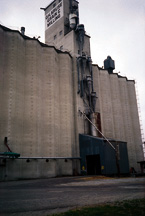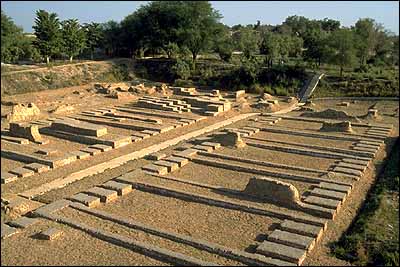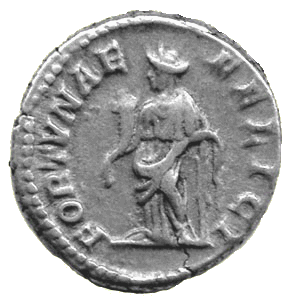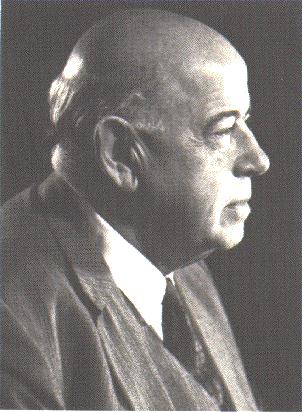
A modern American granary
(Image Source) |
What are Commodity Buffer Stocks?
"Commodity Buffer Stocks" refer to the use of
commodity storage for economic stabilization. Specifically, commodities are
bought and stored when there is a surplus in the economy and they are sold from these
stores when there are shortages in the economy. The institutional buying,
storing and selling of commodities by a large player (e.g. a government) can take place
for one commodity or a "basket of commodities". The stock of commodities
stored act as a buffer against price volatility. If a basket of commodities is
stored, their price stabilization can in turn stabilize the overall price level. |

Granary of Harappa from
Indus Valley civilization (c.2600-1900 B.C.E.).
(Image Source) |
Storage and Stability - An Ancient Idea
The use of commodity buffer stocks against fluctuations, the idea of
an "ever-normal granary", is an ancient idea. For instance, the Bible (Genesis
41-47) informs us that the Egyptians operated an "ever-normal granary", storing
food during the seven years of plenty and then releasing these during the seven years of
famine. Classical China also operated commodity buffer stocks - particular under the
consolidation during the Sui dynasty in the 7th Century. There is also much evidence
that many other civilizations throughout the world have operated commodity buffer stock
schemes for economic stability. |

|
Relation to Agricultural Commodity Price
Stabilization
More recently, commodity buffer stocks have been used to stabilize agricultural
prices both within the United States and other developed countries as well as in many
developing countries and even across countries via international agreements.
Governments or marketing boards, for instance, store or encourage the storing of
commodities in the aftermath of bumper years and then release these stores during poor
harvests. In this way, the prices of agricultural commodities can be
stabilized and farmers can plan their activities with more confidence. |
 
|
What was Benjamin Graham's idea?

B. Graham, 1894-1976
The more general proposition of using a basket of commodities to stabilize output
and prices as a whole was set forth by Benjamin Graham in his
1937 Storage and Stability and elaborated later in his World Commodities and World Currency in 1944. In
the height of the Great Depression, when there was a "general overproduction of
goods", or a "general glut", Benjamin Graham felt that it was paradoxical
that these surpluses of goods which should be regarded as greater wealth, could also cause
so much damage and be feared so much. Commodities, after all, are an asset not a
liability. Instead of laying off workers, cutting back production and reducing
prices - all of which can cause terrible economic and social damage - Graham resurrected
the old idea of an "ever-normal granary" and proposed instead that firms could
maintain steady levels of production and that any general overproduction can be eliminated
by the storage of commodities. Conversely, during periods of
"underproduction", when inflationary pressures are high, the shortage of
commodities as a whole can be eliminated by releasing previously stored commodities onto
the market. Thus, in Graham's proposition, an economy-wide "ever-normal
granary" could stabilize output levels and prices, and thus smooth out the business
cycle, and thus eliminating unemployment and inflation. |

Image of Fortuna, goddess of plenty, on
a Roman denarius.
(Image Source) |
A Commodity-Reserve Currency
Benjamin Graham also proposed the adoption of a "commodity-reserve
currency". This would work effectively like a Gold Standard, except that
backing up currency would not be that single volatile commodity, gold, but rather an
entire basket of commodities. Gold and money fluctuate in their purchasing power of
staple commodities. The "gold reserves" which previously determined
the supply of money in the Gold Standard would be replaced with the very
"commodity reserves" of the ever-normal granary, thus anchoring the money supply
to real purchasing power, impervious to political manipulation (as in the modern system)
and far more stable than a single commodity (as in the Gold Standard). |

Friedrich A. von Hayek

Nicholas Kaldor, 1908-1986 |
What happened to Benjamin Graham's propositions?
Benjamin Graham's 1937 and 1944 books received a considerable amount of attention
and support by leading economists such as John Maynard Keynes, Friedrich A. von Hayek,
Milton Friedman and Frank D. Graham. However, policymakers were reluctant to abandon
the old mystical idea of a gold-backed currency with a commodity-backed currency -
particularly when international agreement was necessary to make the plan effective.
The storage idea, as we noted, has been used extensively in particular commodities like
coffee, tin, and tobacco. But not to the macroeconomy as a whole. Demand
management and politically-controlled money supply has been the norm since the beginning
of the Keynesian era - even though Keynes himself was quite supportive of Graham's ideas
on storage (albeit not on currency).
The famous Cambridge economist Nicholas Kaldor resurrected Graham's ideas in the
1960s, calling for an international commodity-reserve currency - which he called
"Bancor" - based on commodity storage, emphasizing its power to assist commodity
export-dependent developing countries. Kaldor reiterated his call for Bancor
after the unravelling of the Bretton Woods agreements in the 1970s. Modern
economists, such as Robert E. Hall and Leland Yeager, have continued to propose various
aspects of Graham's scheme and the recent resurgence of interest in "sound
money" and economic stability, particularly in light of the Asian Crises of 1997-8
and the Euro experiment, make it as urgent and pertinent as ever.
|
|

![]()